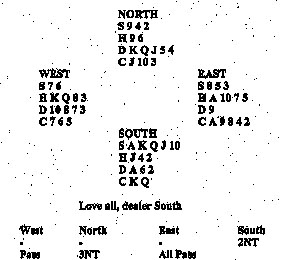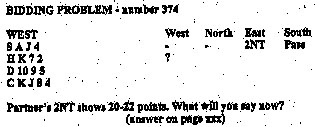|
Bridge
 The
deal comes from a recent
match between the House of Lords and a Cambridge Graduates team,
played in London. Lord Harrison opened 2NT and was raised to 3NT. As
you see, there are five tricks off the top in this contract, whereas
4S would be an easy make. How else might the bidding have gone? Since
a 2NT opening often includes a five-card major, some players use ‘Five-card
Stayman’ in response. You bid 3C to ask for a five-card major. If
partner denies one by bidding 3D, you can then bid any four-card major
to seek a 4-4 fit there. So, North might have used this convention to
seek a 5-3 spade fit. With such good diamonds and poor spades he might
prefer to bid 3NT anyway. What would you have led against 3NT, sitting
West? The fourth-highest of your longest and strongest? Since I am an
‘expert’ (ahem) I preferred to lead a diamond. Lord Harrison found
this very much to his liking and soon had ten tricks before him. Both
West players for the House of Lords led the three of hearts to partner’s
ace. Both Easts then returned the ten of hearts, with the idea of
killing dummy’s nine. It did not work well. West took the next three
heart tricks but did not know where to seek a fifth trick. At both
tables West switched to a spade and the contract succeeded. East
should return his fourth-best heart at Trick 2. He will then win the
fourth round of hearts with the ten and can cash the ace of clubs. The
deal comes from a recent
match between the House of Lords and a Cambridge Graduates team,
played in London. Lord Harrison opened 2NT and was raised to 3NT. As
you see, there are five tricks off the top in this contract, whereas
4S would be an easy make. How else might the bidding have gone? Since
a 2NT opening often includes a five-card major, some players use ‘Five-card
Stayman’ in response. You bid 3C to ask for a five-card major. If
partner denies one by bidding 3D, you can then bid any four-card major
to seek a 4-4 fit there. So, North might have used this convention to
seek a 5-3 spade fit. With such good diamonds and poor spades he might
prefer to bid 3NT anyway. What would you have led against 3NT, sitting
West? The fourth-highest of your longest and strongest? Since I am an
‘expert’ (ahem) I preferred to lead a diamond. Lord Harrison found
this very much to his liking and soon had ten tricks before him. Both
West players for the House of Lords led the three of hearts to partner’s
ace. Both Easts then returned the ten of hearts, with the idea of
killing dummy’s nine. It did not work well. West took the next three
heart tricks but did not know where to seek a fifth trick. At both
tables West switched to a spade and the contract succeeded. East
should return his fourth-best heart at Trick 2. He will then win the
fourth round of hearts with the ten and can cash the ace of clubs.
 Answer Answer
A total of 32 points
will not be enough for a small slam, particularly as you have such a
flat hand. You need a response that will ask partner to advance to 6NT
when he is upper-range for his opening. The bid that asks just this
question is 4NT. When partner is lower-range, he will pass. AWARDS:
4NT-10, 6NT-6, Pass-4.
David Bird
— Knight Features
|